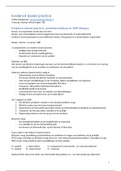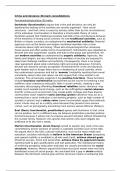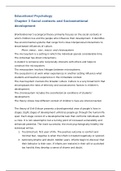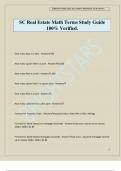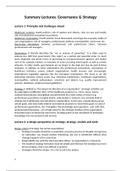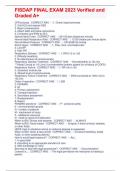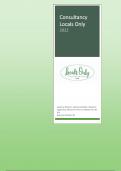HC introduction to animal free innovations
In the two areas with arrows there is a need for better physiologically relevant human models >
medication might not work in animals and would have worked in humans or the other way around +
personalized medicine.
Transition to animal free methods for testing consumer products and drugs > how far the transition
is varies between type of organs/ area of expertise > skin models for testing cosmetics all the way
there but the brain has still a very long way to go.
HC introduction to the innate and adaptive immune system
First line of defense: physical barriers (skin, hair, and nails), chemical barriers (los pH, mucus,
enzymes), microbiological barriers (normal flora of the skin and in the intestine).
Second line of defense: phagocytosis, complement, interferon, inflammation, fever, innate immune
system.
,Third line of defense: lymphocytes,
antibodies, Tc-cells = adaptive immune
system.
Functions complement formation of the
membrane attack complex = bacterial lysis,
initiation of inflammatory response, and
opsonization and phagocytosis.
Most neurtophils because they die when
they kil a pathogen (granulocytes) > same
for eosinophils and basophils >
Neutropjils deliver multiple anti-microbial molecules: nets (consisting of DNA) that trap bacteria and
neutrophil elastase, granules, oxigen radicals, calprotectin.
,NK-cells have both activating and ihibiting receptors > tumor/virus > causes stress in host cells >
transformation > expression of MIC & ULBP (human)/RAE-1 (mouse) > strong activation ligands > NK
kills the cells by cytokine production and cell lysis. MHC class 1 is a sprong inhibition ligand =
recognision of self cells > no kill. Infected cells/tumor cells down regulate MHC class 1 to escape from
activated T-cells > enables NK cells to kill these infected ‘self’ cells = missing self hypothesis.
Every tissue has his own type of
macrophages and dendritic cells > stay in
the tissue wainting for infection > vary in
characteristics and skills.
Macrophages are highly plastic cells >
pro-inflammatory, tissue regeneration,
and anti-inflammatory skills.
Pattern recognition receptors (PRR):
, ➢ Discrimination between self and non-self and between healthy versus damaged tissues
➢ Extracellular and intracellular receptors
➢ Recognition of Pathogen Associated Molecular Patterns (PAMPs) and Danger Associated
Molecular Patterns (DAMPs)
➢ Molecular signatures of invading pathogens: DNA/RNA, Cell wall components, such as lipids,
sugars, proteins
➢ Signs of tissue damage: Uric acid, Heat-shock proteins, HMGB1, mtDNA
➢ Types of PRR: Toll-like receptor, C-type lectin receptor, NOD-like receptor and RIG-I-like
receptor (both recognize DNA structures).
Two types of toll-like receptors: cell surface TLRs and intracellular TLRs (endosomes). Stimulation of
different TLRs lead to the trigger of different pathways and the production of different functional
molecules (pro-inflammatory cytokines or costimulatory molecules or type 1 IFN). The combination
of PRRs triggered determines the innate response.
Mature DCs need to provide 3 signals to
activate naïve T cells: signal 1 = TCR
needs to recognise the antigen in MHC2.
Siganl 2 = costimulation CD80/CD86 with
CD28. Signal 3 = cytokines.
Dendritic-cell polarization is
influenced by the type of
microorganism that is recognized >
CD4 Thelper responses determined by
interaction pathogens
and cytokines (signal 3)
In the two areas with arrows there is a need for better physiologically relevant human models >
medication might not work in animals and would have worked in humans or the other way around +
personalized medicine.
Transition to animal free methods for testing consumer products and drugs > how far the transition
is varies between type of organs/ area of expertise > skin models for testing cosmetics all the way
there but the brain has still a very long way to go.
HC introduction to the innate and adaptive immune system
First line of defense: physical barriers (skin, hair, and nails), chemical barriers (los pH, mucus,
enzymes), microbiological barriers (normal flora of the skin and in the intestine).
Second line of defense: phagocytosis, complement, interferon, inflammation, fever, innate immune
system.
,Third line of defense: lymphocytes,
antibodies, Tc-cells = adaptive immune
system.
Functions complement formation of the
membrane attack complex = bacterial lysis,
initiation of inflammatory response, and
opsonization and phagocytosis.
Most neurtophils because they die when
they kil a pathogen (granulocytes) > same
for eosinophils and basophils >
Neutropjils deliver multiple anti-microbial molecules: nets (consisting of DNA) that trap bacteria and
neutrophil elastase, granules, oxigen radicals, calprotectin.
,NK-cells have both activating and ihibiting receptors > tumor/virus > causes stress in host cells >
transformation > expression of MIC & ULBP (human)/RAE-1 (mouse) > strong activation ligands > NK
kills the cells by cytokine production and cell lysis. MHC class 1 is a sprong inhibition ligand =
recognision of self cells > no kill. Infected cells/tumor cells down regulate MHC class 1 to escape from
activated T-cells > enables NK cells to kill these infected ‘self’ cells = missing self hypothesis.
Every tissue has his own type of
macrophages and dendritic cells > stay in
the tissue wainting for infection > vary in
characteristics and skills.
Macrophages are highly plastic cells >
pro-inflammatory, tissue regeneration,
and anti-inflammatory skills.
Pattern recognition receptors (PRR):
, ➢ Discrimination between self and non-self and between healthy versus damaged tissues
➢ Extracellular and intracellular receptors
➢ Recognition of Pathogen Associated Molecular Patterns (PAMPs) and Danger Associated
Molecular Patterns (DAMPs)
➢ Molecular signatures of invading pathogens: DNA/RNA, Cell wall components, such as lipids,
sugars, proteins
➢ Signs of tissue damage: Uric acid, Heat-shock proteins, HMGB1, mtDNA
➢ Types of PRR: Toll-like receptor, C-type lectin receptor, NOD-like receptor and RIG-I-like
receptor (both recognize DNA structures).
Two types of toll-like receptors: cell surface TLRs and intracellular TLRs (endosomes). Stimulation of
different TLRs lead to the trigger of different pathways and the production of different functional
molecules (pro-inflammatory cytokines or costimulatory molecules or type 1 IFN). The combination
of PRRs triggered determines the innate response.
Mature DCs need to provide 3 signals to
activate naïve T cells: signal 1 = TCR
needs to recognise the antigen in MHC2.
Siganl 2 = costimulation CD80/CD86 with
CD28. Signal 3 = cytokines.
Dendritic-cell polarization is
influenced by the type of
microorganism that is recognized >
CD4 Thelper responses determined by
interaction pathogens
and cytokines (signal 3)

